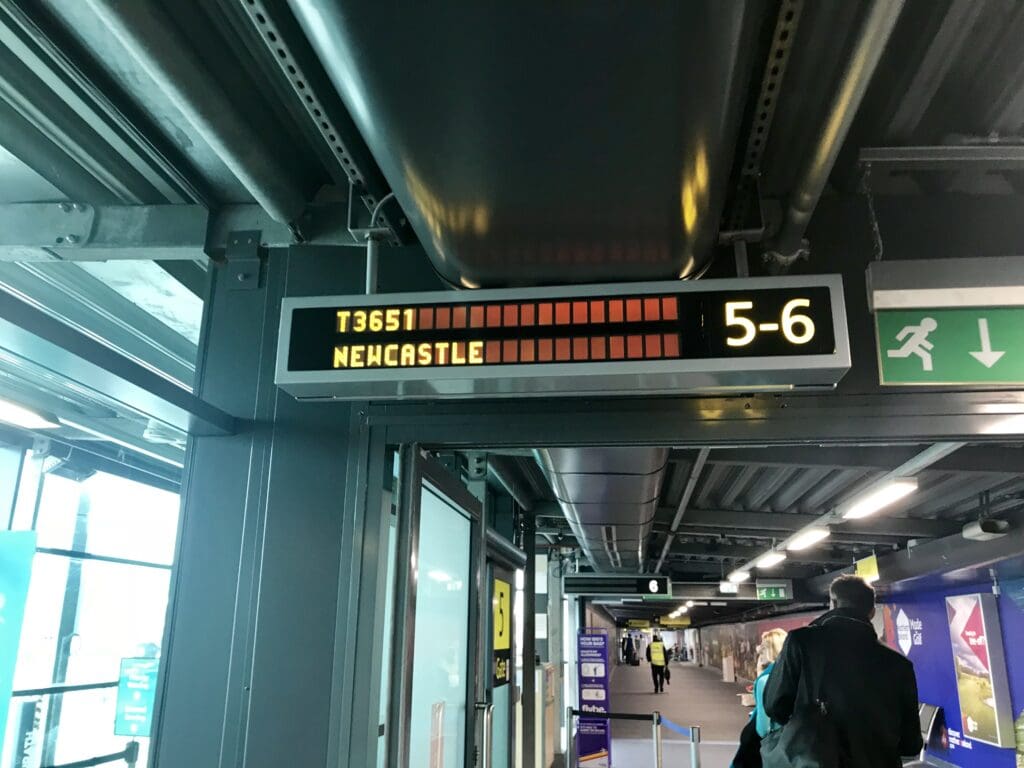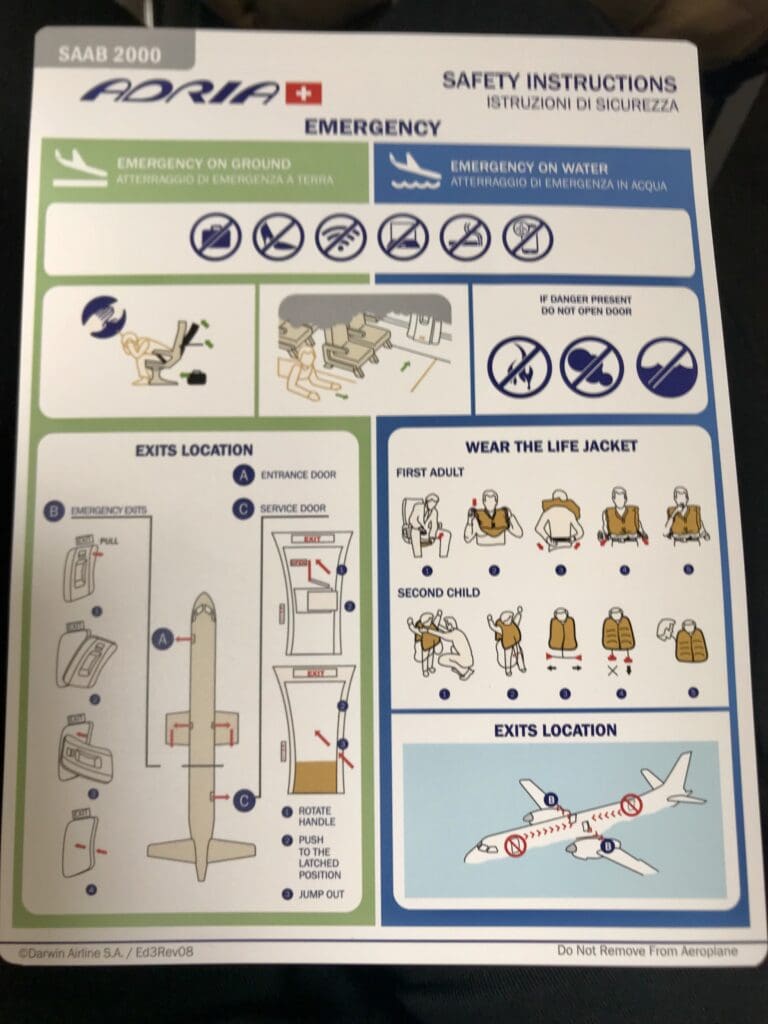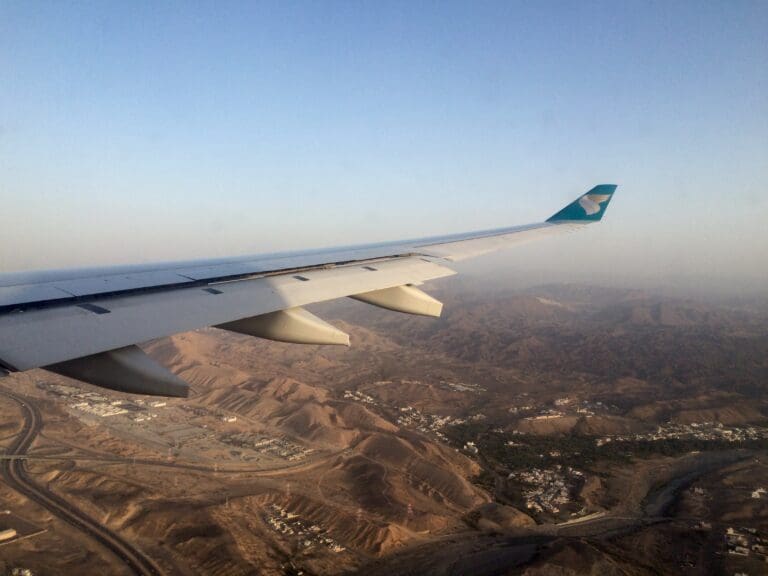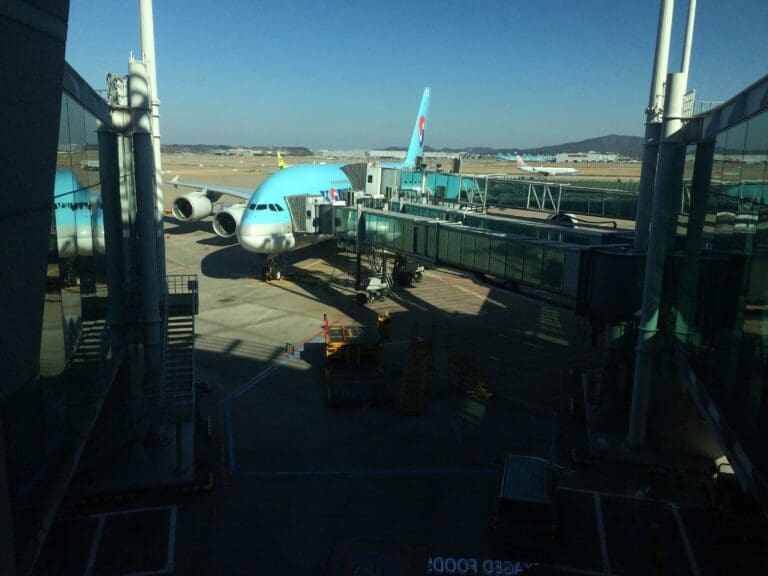Adria Airways Switzerland Review: Belfast to Newcastle on a Rare Saab 2000

Disclaimer
This trip took place back in 2017, I have reuploaded this as I have recently moved blogs! Unfortunately, Eastern Airways no longer operate the route between Newcastle, Belfast City and the Isle of Man. Additionally, Adria Airways Switzerland halted operations three months after this trip and today the Saab 2000 is a tricky aircraft to fly on in Europe (and indeed most of the world)
Background
In August and September 2017, Humberside headquartered British regional carrier Eastern Airways wet-leased a single nineteen-seat British Aerospace BAe Jetstream 32 from the small Dutch airline, AIS Airlines. Based at Newcastle, this was pressed into service on routes to Aberdeen and the Isle of Man via Belfast City. Whilst this small turboprop airliner was once commonplace in British skies and seen at airports up and down the country, by the time my interest in aviation developed into reviewing flights, the type was firmly on its way out. Unfortunately, I failed to catch a ride on any of the remaining examples before their removal from scheduled service in 2015.
Sampling these in mainland Europe is however possible, with AIS Airlines operating these on a couple of domestic flights in Germany from Munster to both Berlin and Stuttgart, as well as in Sweden. However, based in London, travelling to the continent to sample these would prove to be significantly more expensive than catching one on a domestic hop in the UK. Thus, once I found out about this wet-lease I made my way to Eastern Airways’ modern and easy-to-use website. Following a quick search for flights, I parted with £58 in exchange for a ticket from Belfast City to Newcastle – with this fare including 15kg of hold luggage (not that this was needed seeing as this would be a day trip!). A short time later I realised that the fare was the exact same for those making the entire trip from the Isle of Man to Newcastle via Belfast City, and so I kicked myself for missing out on a second leg in this rare turboprop. On the plus side, getting from London to Belfast proved to be cheaper than to the Isle of Man, and I settled for a morning ride up from London City Airport onboard a Flybe Dash 8 Q400. Following my exciting flight, I would then return to the capital city on a Virgin Trains East Coast service to London King’s Cross in the evening.
However, all did not go entirely to plan, and whilst Eastern Airways’ booking engine still showed the flight as being operated by an AIS Airlines Jetstream 32, a week or so before my departure it appeared that this aircraft had returned to its base in Lelystad, with an Adria Airways Switzerland Saab 2000 stepping in to take its place. Whilst I was slightly disappointed, seeing as I was yet to fly on a Saab turboprop, and with the Saab 2000 becoming increasingly rare in Europe, I was still happy that I would get the chance to fly on something a little different!
London City to Belfast City
On the morning of my adventure, I caught Flybe’s second oldest Dash 8 Q400, G-JEDP, appropriately named ‘Sprit of Belfast’ from London City. The flight was pretty uneventful and thus I don’t have too much to say about it so I’ll leave you with some pictures instead.






Belfast City to Newcastle
Upon touching down in Northern Ireland onboard the purple Dash 8, I was both expecting and hoping to see the Saab 2000 on the airport’s small apron being readied for its short hop over to the Isle of Man on the outbound leg of its trip. Instead, all that could be seen upon arrival was a trio of fellow Flybe Dash 8s. A quick check of FlightRadar24 revealed that the aircraft was still yet to depart Newcastle, in fact, this ended up taking off an hour late. This would have not been particularly concerning were it not for my ticket on the 1625 departure to London King’s Cross that afternoon. Were I to miss that train, my day trip would become notably more costly as I would have to fork out at least £90 for a new ticket down to London!
Despite arriving in Belfast slightly behind schedule, I still had a reasonable amount of time before my flight to Newcastle. Thanks to Eastern Airways’ lack of online check-in facilities, put off by the cold drizzle outside, I had little to do but wait in the viewless landside portion of the airport. As one would expect from a ‘city’ airport, this was rather small, consisting of a bank of check-in desks, a WHSmiths and a Costa Coffee as well as multiple vending machines selling various drinks and snacks. Aside from the lack of views, I was not left with much to complain about – the terminal was modern, clean and relatively quiet whilst fast, free wifi was on offer to help pass the time. As time passed, the number of passengers steadily increased thanks to the 1230 and 1250 departures to Heathrow operated by Aer Lingus and British Airways Airbuses respectively. Turning to examine the small check-in area, there, Aer Lingus, British Airways, Flybe and KLM all enjoyed their own dedicated areas whilst Eastern Airways had a single unmanned desk which the departure boards claimed to be open.
Eventually, a Menzies airport worker appeared, thereby indicating the opening of check-in and so I made my way over to the desk. As soon as I arrived there I was greeted by a very friendly check-in agent and handed over my driving licence. Whilst I suspected that I would be allocated a single seat on the left side of the aircraft, I nevertheless requested a window seat. However, I was informed that an open seating policy would be in effect on the flight and told not to worry as the aircraft would be larger than the scheduled type and therefore there would be plenty of spare seats (this being something that I was unfortunately already aware of!). I was then handed a Menzies branded boarding pass and wished a nice flight after which I headed over to the security area.
Thanks to the two London bound flights, security featured a rather long queue and a good fifteen minutes of waiting was required before I finally reached the actual security check. In a slightly LCC terminal-esque style, I noticed that the security area featured a ‘shed style’ roof, something that appears to be fairly common at smaller regional airports across the UK. Once through security, I headed up the escalator to the somewhat crowded airside departure area. Outside the ramp had become a little busier since my arrival, with the Flybe Dash 8s now joined by three Airbus A320s – two operated by Aer Lingus and one by British Airways. Rather surprisingly given their lack of scheduled services to the airport, a Lufthansa CityLine Embraer, presumably on some sort of special charter, could also be seen and was set to head off to Munich later that afternoon.
Checking the departure boards, these now showed the Newcastle flight as departing at 1404 and thus my worries about missing the train were slightly alleviated. At 1330, I caught sight of the pencil-like Saab 2000 making its way towards the stand that had previously been occupied by the Heathrow-bound Aer Lingus Airbus. As this pulled into the stand, the aircraft’s two turboprop engines were a little noisier than expected and temporarily filled the terminal with noise.
The aircraft operating the flight that day would be HB-IZP, the 31st Saab 2000 to be produced out of a total of 63 examples. Manufactured at Saab’s factory in Linkoping, this made its first flight in January 1996 with the test registration SE-031. Just over a month later the aircraft was given the same Swiss registration it wears today and was handed over to the then-giant Saab operator, Crossair. After over five years service, in September 2001 the aircraft was flown back to its homeland to begin a five-year term with Golden Air. In September 2006, the aircraft returned to Saab and was given the registration SE-031 again. After several months in storage, in February 2007, the aircraft was flown across to Smith Reynolds Airport in Winston-Salem, North Carolina to begin a new career shuttling members of NASCAR team Ginn Racing across the USA. Just over three years later, the aircraft was flown back to Europe to fly once again in Switzerland, specifically for the regional airline, Darwin Airline based in the picturesque alpine lakeside city of Lugano. In 2014, the aircraft began operating for Etihad Regional, shuttling passengers from Geneva to France, Italy and Spain until the airline’s downfall a year later. Following Darwin Airline’s purchase by Adria Airways, Adria Airways titles were painted onto the aircraft and at the time of my flight, the aircraft sported a hybrid Etihad Regional-Adria Airways livery. In the week before my flight the aircraft had operated twenty flights under a veritable mixture of Darwin Airline, Adria Airways and Eastern Airways flight numbers, travelling around 7,900 miles visiting Belfast City, Biarritz, Bologna, Geneva, Guernsey, Ibiza, the Isle of Man, Lamezia Terme, Lugano and Newcastle.

By the time the aircraft had pulled into the gate, a small group of passengers had formed around the doors that led to the gate area downstairs. This led me to believe that the flight was going to be moderately full, however when boarding was called at 1335 and these doors opened, only seven passengers including myself headed down to Gate 6. Upon arriving there, the Menzies staff member who checked us all in scanned our boarding passes before we were all led out to the waiting aircraft. As I made my way towards the aircraft, I heard those behind me remarking about how small the aircraft was; I imagine they would have had quite a shock had we been making the journey on a Jetstream 32!

After climbing up the aircraft’s steps, I was given a friendly welcome by the aircraft’s sole flight attendant and advised to sit wherever I pleased. Wanting a view that would not be too obstructed by the wing I headed to the rear of the aircraft, opting to fly over the Irish Sea in Seat 15A. Having been unsure of how many passengers would be making the entire trip from the Isle of Man to Newcastle, this turned out to be a meagre total of three, all of whom were seated several rows in front of me. These consisted of a talkative elderly couple and a younger passenger who, through their conversations with the couple I deciphered was a Newcastle-based university student from the Isle of Man. Meanwhile, with the exception of myself, all of those who joined the flight in Belfast were dressed in business attire hinting at the purpose of their journeys that afternoon.


With fifty seats in a 1-2 configuration, the load onboard the aircraft was just 10%, making it perhaps the emptiest commercial flight that I have taken. Briefly examining the cabin, onboard the Saab 2000, the seats on either side of the aisle are located on slightly raised platforms whilst, being of slightly above average height, I was able to just stand upright in the aisle without banging my head on the cabin’s ceiling. Turning to the overhead lockers, these were far from large, however, thankfully there was plenty of space for passengers to store any oversized hand luggage that afternoon. Given the aircraft’s former life operating on behalf of Etihad Regional, this particular Saab featured large, well-padded (faux?) leather seats in Etihad Airways’ desert beige brand colour. Upon sitting down, I was pleased to find that these were as comfortable as they looked, whilst, for a regional turboprop, the amount of legroom provided was fantastic. Unsurprisingly given the light load, the cabin was spotlessly clean although I did find several marks and scratches dotted about around my seat. Turning to the seatback pocket, this contained a copy of Adria Airlines Switzerland’s ‘Evolution’ magazine alongside the usual safety card and sick bag.





Around ten minutes after boarding had been called in the terminal, the aircraft’s built-in stairs were retracted into the cabin and the main cabin door was shut. A few moments later, the captain performed a welcome announcement, informing the ten passengers onboard that he expected an ahead-of-schedule arrival and that the flight would last a grand total of thirty minutes. Once this was done, the flight attendant performed another welcome announcement before undertaking a brief safety demonstration. After this and whilst still on the stand, the flight attendant passed through the cabin, checking all was ready for departure. Given the short flight time, the complimentary snack service was undertaken whilst the aircraft was still on the ground, this involved the passing around of a snack basket which was full of upmarket crisps, small KitKats and Nature Valley cereal bars. Although the crew member appeared to have no problem with passengers taking more than one item, feeling a little restrained, I resigned myself to a single cereal bar which I consumed later on during the flight.

A short while later, the Saab suddenly jolted back with a notable amount of force as if the driver of the tug was not expecting the aircraft to move with such ease. This was then followed by a slightly high-pitched squeal just before the two Allison AE 2100A engines whirled into life filling the cabin with noise and the slight scent of fuel. Interestingly, the AE 2100 family of engines are fairly common in the world of military aviation, powering the Alenia C-27J, the C-130J Super Hercules and the ShinMaywa US-2. Once the two engines had come alive, the flaps were partially extended and the aircraft began its taxi to holding point A1. Sitting on the port side of the aircraft, the short journey to runway 22 allowed for views of David and Goliath, the two landmark cranes at the Harland and Wolff shipyards, the birthplace of the ill-fated RMS Titanic, as well as the Bombardier factory. In the harbour, the funnels of cargo ships and Stena Line ferries ready to ship passengers, cars and lorries across the Irish Sea could be seen. Meanwhile, those on the starboard side of the aircraft were treated to good views of several car parks and an Ikea store.

After reaching the holding point, the aircraft held for a few minutes whilst an Aer Lingus A320 departed off to a likely sunnier Malaga and G-JEDP, the same aircraft I had arrived in Belfast on several hours earlier arrived from Exeter. Once this aircraft had touched down, we made a quick backtrack to the end of the runway before turning around. Then, all of a sudden our two engines were powered up, providing up to around 8300 units of horsepower and we were all pushed back into our seats. The powerful engines combined with the low load resulted in what I can only call the most powerful departure I have experienced in an airliner. After a quick rotation, the feeling of power continued to push us into our seats as we climbed upwards above Belfast.



Unfortunately, the low clouds meant that few views of Belfast could be had before climbing up into the clouds. Whilst still climbing through these, the seatbelt signs were extinguished which was accompanied by the announcement ‘‘cabin crew, you are released’. At this time the flight attendant brought a cart down the aisle, commencing the second half of the onboard service – drinks. Whilst there seemed to be a decent selection of options onboard, I opted for a plain and simple still water and was handed a 250ml bottle of Highland Spring along with a plastic cup.


After leaving Belfast behind, the aircraft turned over Strangford Lough, rolling out on a heading of around 75 degrees. As the aircraft climbed up to its cruising altitude of 21,000 feet, we passed just south of Cairngaan, which according to Wikipedia is the southernmost settlement in Scotland. From there the aircraft passed just to the south of the Isle of Whithorn (not actually an island) and crossed the Solway Firth, making landfall over England just to the north of the Cumbrian town of Maryport. Unfortunately, thanks to the thick clouds beneath the aircraft, disappointingly none of the picturesque rural scenery beneath the aircraft could be seen. Meanwhile, inside the cabin, I noticed that the engines proved themselves to be rather noisy, far more so than on an ATR or a Dash 8. Almost immediately after reaching the English coastline and a grand total of two minutes after levelling off, the aircraft commenced its descent.

Shortly after passing over Carlisle, the aircraft sank into the clouds and the seatbelt signs were reilluminated just before things began to get a little bumpy. By the time the aircraft sank beneath the bulk of the clouds, we were flying just to the south of the town of Morpeth before passing over Cambois and heading out over the green-blue cold-looking North Sea. The aircraft then made a shallow turn off the coast of Blythe to line us up for the final approach to Newcastle Airport’s Runway 25 at which point the extension of the landing gear could be seen, heard and felt.





As the aircraft approached the airport, the turbulence seemed to largely smooth out as we passed over a mix of townscape, fields and farms before darting down over the airport’s perimeter fence. At 1439, a grand total of 38 minutes after leaving Belfast, the aircraft made a rather rough touchdown in Newcastle which was followed by some gentle braking as the aircraft decelerated. At this point, a former WestJet Boeing 737-200 of 1969 vintage appeared which is now used as an instruction airframe by the Newcastle Aviation Academy, as well as an active ex-RAF BAC Strikemaster.






Once off the runway, the flight attendant performed a brief welcome announcement whilst outside the terminal came into view. Here, a selection of jets could be seen, these coming in the form of an Easyjet Airbus A319, a TUI Boeing 737-800 alongside a couple of BMI Regional Embraers and a few Jet2 Boeing 737s. Within a few moments, the aircraft pulled into Stand 20 where a bus could be seen waiting, ready to transport passengers onwards to the terminal. Once the engines were shut down, the cabin temporarily fell silent whilst inside there was no rush to disembark. After a minute or so, the cabin door opened and passengers began to slowly lumber up and make their way down the aircraft steps and towards the waiting bus. After thanking the friendly flight attendant, I too exited the aircraft and once onboard the bus, being the last passenger to disembark, the doors closed and this headed off in the direction of the terminal. Once there, I made my way to the airport’s conveniently located metro station and headed off on a bright yellow box-like train towards Newcastle’s city centre.


Summary
Whilst I was a little disappointed at missing out on the opportunity to sample a flight on a Jetstream 32, all in all I had a pleasant experience onboard the Saab 2000, so I could not really make any reasonable complaints.








Seems like a cool (and quite rare) plane to fly on.
Closest I’ve come is the similar but shorter Saab 340, which is also very loud in the cabin. No galley in the back meant a “back bench” of 4 seats.
Yes agreed! Here in the UK the Saab 340s only bowed out from passenger service in Scotland earlier this year. Despite being quite noisy the feedback that I’ve had from the pilots is that many prefer the old Saabs to the ATRs that replaced them – they can take more of a battering from the wind and weather, making them suitable for operations in Northern Scotland.